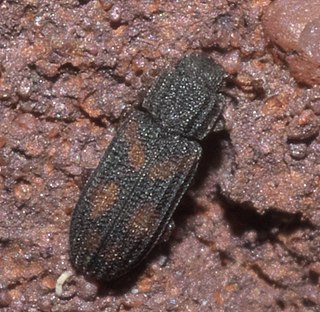
The western meadowlark is a medium-sized icterid bird, about 8.5 in (22 cm) in length. It nests on the ground in open grasslands across western and central North America. It feeds mostly on bugs, but will also feed on seeds and berries. The western meadowlark has distinctive calls described as watery or flute-like, which distinguish it from the closely related eastern meadowlark. The western meadowlark is the state bird of six states: Montana, Kansas, Nebraska, North Dakota, Oregon, and Wyoming.
Helicia neglecta is a species of plant in the family Proteaceae. It is endemic to Papua New Guinea. It is threatened by habitat loss.

Frasera, the green gentians, is a genus in the gentian family, native to North America and named for John Fraser, a Scottish botanist and colleague of Thomas Walter.

Agave weberi, known as maguey liso in Spanish and as Weber agave in English, is a succulent perennial plant in the family Asparagaceae, subfamily Agavoideae. Under the synonym Agave neglecta, it is known as wild century plant and Small agave – the latter in honor of its discoverer in Florida, John Kunkel Small. Naturalized populations in Florida were considered to be a separate species, but are now treated as synonymous with A. weberi.

Eucalyptus neglecta, commonly known as Omeo gum, is a species of small tree that is endemic to a small area of Victoria, Australia. Older plants have rough, fibrous bark on the trunk, otherwise smooth grey to brownish bark, a crown of mostly lance-shaped, egg-shaped or oblong leaves arranged in opposite pairs, flower buds in groups of between seven and fifteen, white flowers and cup-shaped or conical fruit.
Bitoma carinata is a species of cylindrical bark beetle in the family Zopheridae. It is found in North America.

Bitoma is a genus of cylindrical bark beetles in the family Zopheridae. There are about 15 described species in Bitoma.

Atalantycha is a genus of soldier beetles in the family Cantharidae. There are at least four described species in Atalantycha.

Bitoma quadriguttata is a species of cylindrical bark beetle in the family Zopheridae. It is found in North America.

Acmaeodera neglecta is a species of metallic wood-boring beetle in the family Buprestidae. It is found in North America.
Bitoma vittata is a species of cylindrical bark beetle in the family Zopheridae. It is found in North America.

Bitoma crenata is a species of cylindrical bark beetle in the family Zopheridae. It is found in North America and Europe.
Bitoma sulcata is a species of cylindrical bark beetle in the family Zopheridae. It is found in Central America and North America.
Bitoma quadricollis is a species of cylindrical bark beetle in the family Zopheridae. It is found in North America.
Panorpa neglecta is a species of common scorpionfly in the family Panorpidae. It is indigenous to North America.
Copromyza neglecta is a species of lesser dung fly in the family Sphaeroceridae. It is found in Europe.
Bitoma exarata is a species of cylindrical bark beetle in the family Zopheridae. It is found in Central America, North America, and South America.
Exema neglecta is a species of warty leaf beetle in the family Chrysomelidae. It is found in North America.
Leiodes neglecta is a species of round fungus beetle in the family Leiodidae. It is found in North America.
Notothenia neglecta is a species of fish found in the Southern Ocean in Antarctica. They are omnivorous, and are found in both benthic and pelagic regions of the ocean. Their diet includes krill, bivalves, and gastropods. They have evolved unique behaviors and morphological features in order to thrive in the cold and harsh Antarctic climate. N. neglecta is also commercially fished, although not in high numbers.







